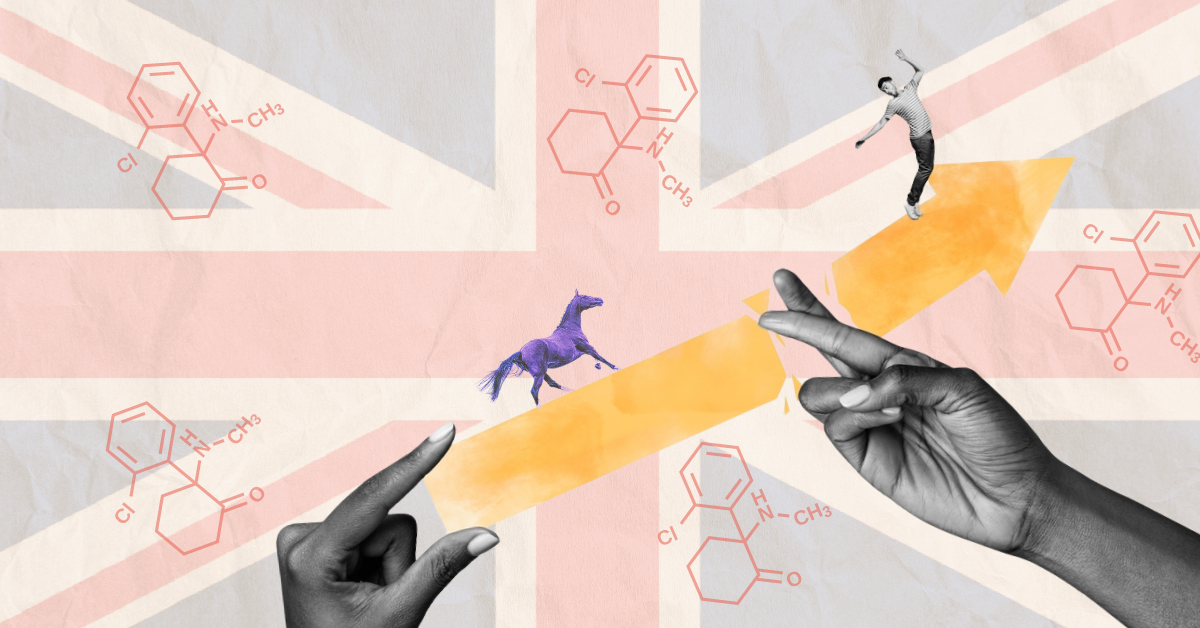Ketamine was first made in 1962 as a replacement for phencycylidine (PCP). Because of its safety profile, it soon became widely used by doctors as an anaesthetic and analgesic with adults and children, as well as being used by vets on animals. However, sensationalist media coverage preferred to describe it as a “horse tranquilliser” rather than a human medicine.
Ketamine impacts glutamate and dopamine transmission in the brain, thus modifying all major psychological systems, namely memory, cognition, perception, motivation and affect. It’s usually snorted, but also injected or absorbed through the mouth or rectum (boofing). Its effects are dose-related: a small dose (bump) produces a short-lived woozy high, while larger doses invoke the Alice in Wonderland-like alternative reality of the K-hole – a dissociative state on the edge of anaesthesia, involving euphoria, hallucinations, altered consciousness, near-death experiences and even machine elves. Many users combine ketamine with toots of cocaine (known as CK or Calvin Klein) – to improve cognition and communication – while clubbers and ravers often do bumps of K to boost the effects of ecstasy. Ketamine is not as well known to the public as a “traditional drug”, and mainly gets mentioned by the media as a new therapy for depression or when someone dies on it.
The prohibition of ketamine
Ketamine was not prohibited by the UK’s Misuse of Drugs Act until 2006 – as a class C, schedule 4 drug. Methoxetamine (MXE), a closely related drug with longer-acting effects, was soon being sold as a legal high to sidestep this law. The government responded by introducing the first Temporary Class Drug Order on methoxetamine in 2012. Alongside other arylcyclohexylamines, methoxetamine was made a Class B and schedule 1 drug (no medical use) in 2013. In 2014, ketamine was also upgraded to class B but moved up to schedule 2 only, to permit continued medical use.
How has the prohibition of ketamine in the UK impacted its illicit sale and use, and the risk of harmful consequences? Let’s take a look at trends in official statistics and recent reports on key issues.
The rise in ketamine use
Prior to 1990, ketamine was an obscure drug used by psychonauts. Clubbers added it to their repertoire of dance drugs over the 1990s. But it was not that popular beyond these niche markets until after it was prohibited in 2006. According to the Criminal Survey of England and Wales, lifetime ketamine use nearly tripled among adults (16-59) from 2006/07 to 2022/23. Among young adults (16-24), lifetime use more than doubled over that period. Use in the past 12 months also tripled for all adults and quadrupled among young adults. Over the last month ketamine use quadrupled for both groups. Record numbers now report that almost 1,25 million adults have used ketamine, with about 300000 having used ketamine in the past year. Meanwhile lifetime ketamine use by English secondary students remains below 1%, though reached 2.7% for 15-year-olds in 2021.
Are these surges in ketamine use related to the impact of prohibition laws? The graph shows to distinct periods of increasing ketamine use among young adults for both lifetime use and last-year use: the first from 2006/07 to 2010/11, following the 2006 ketamine prohibition, and the second steady rise from 2015/16 to 2022/23, after the 2014 reclassification.

Ketamine is now the UK’s most popular hallucinogen. It has become the fifth most prevalent form of recent drug use reported by adults – after cannabis, nitrous oxide, cocaine and ecstasy. Like cocaine and ecstasy, it’s clear that ketamine use has now moved beyond niche markets to claim its place in the broader recreational drug scene of Britain. Similar trends have been reported in Ireland: “Ketamine [is] following a similar trajectory to other ‘club drugs’ moving from the margins to more mainstream use”.
Statistics on drug seizures from the police and Border Force in England & Wales reveal a surge after its prohibition, peaking at 1,793 in 201/11 and dropping to 556 in 2014/15. After reclassification in 2014, seizures increased to new heights of 1,509 in 2020/21 and 1,487 in 2022/23. The seized ketamine quantity rose sharply from 293kg in 2009/10 to 1,837 in 2021/22. WEDINOS reported ketamine as the second most prevalent substance in 1,112 samples from 22 night time economy (NTE) venues in Wales in 2021/22, surpassing heroin and amphetamine seizures.
The rise in adulteration of ketamine
The 2006 ban on ketamine had a predictable impact on market factors like price and purity. The gram price of ketamine from local dealers has risen from around £10-15 in the 1990s to £20-40 in the 2020s, averaging £30, though is typically cheaper when purchased on the Dark Net. The ketamine consumed in the 1990s was mostly imported from pharmaceutical sources in countries like India, so was often sold in the form of vials containing a solution of ketamine hydrochloride. In short, it was typically pure and unadulterated. But after 2005, illicit production and supply of ketamine began to replace diverted pharmaceutical supplies, and the main product became ‘dry’ ketamine – anything between a crunchy powder and glassy shards.

A review by the ACMD reported that the purity of ketamine seizures in 2012 ranged from pure down to 76%.
Between 2013 and 2020, WEDINOS analysed 321 ketamine samples. Results showed that 75% contained only ketamine, 13% had ketamine mixed with other drugs, and 13% contained other drugs but no ketamine. Common adulterants were stimulants (cocaine, amphetamines) and empathogens (MDMA, cathinones). In the second half of 2023, most ketamine samples analysed contained only ketamine, presumably cut with other substances like MSG. However, some samples contained ketamine with adulterants such as cocaine, benzocaine, mephedrone, ortomephedrone (2-MMC), metaphredone (3-MMC), benzocaine, diazepam, dihydrocodeine and paracetamol. Some samples of ketamine were totally fake, with no drugs at all being identified.


A further harmful impact of prohibition is that ketamine is now increasingly found as an adulterant in other drug products. Over 2023, WEDINOS samples of other drugs found to be cut or contaminated with ketamine included drug products purchased as ecstasy, cocaine, amphetamines, cathinones, benzodiazepines and even THC vapes. WEDINOS has also reported on several samples of tuci (tusi, pink cocaine), a multi-drug cocktail which originated in South America, and these were consistently found to contain ketamine and MDMA.
The rise in ketamine-related harm
Regular or heavy use of ketamine can lead to several problems, including dependence, psychological disorders, and health problems such as damage to the urinary system.
Problematic ketamine use increased significantly after it was prohibited in 2006. Adult treatment presentations in England involving ketamine rose from 116 in 2005/06 to a peak of 2211 in 2022/23, a nineteen-fold increase, with a 30% rise in the last two years. Total adults in treatment for ketamine reached a record 3,041 in 2022-23, up 30% on the previous year. Ketamine cases for under-18s climbed fifteen-fold from 35 in 2005/06 to over 500 per year since 2019/20. Primary ketamine treatment cases rose from 11 to 103 over 17 years. Notably, treatment presentations began rising in 2015/16, the year after ketamine was reclassified.
The 2022/23 report from the National Poisons Information Service highlighted a 25% increase in ketamine-related incidents. Yet, tracking trends in harms is challenging because official statistics on mental disorders, health issues, poisoning, and deaths don’t provide specific figures for ketamine, unlike other illicit drugs.
The rise in ketamine deaths
The average lethal dose of ketamine is about 2.7 grams, about 40 times higher than the average effective dose, though susceptible people or poly-drug users may fatally overdose on half that amount.
Although annual bulletins on drug-related deaths do not provide figures for ketamine, Corkery et al. (2021) analysed 231 ketamine-related deaths reported to Coroners in England from 1997 to 2019. Before 2005, deaths were zero to two per year, but they increased to 10-20 per year after 2005, reaching 30 in 2017 and a projected peak of over 50 in 2019. Notably, rises in ketamine-related deaths occurred after its prohibition and reclassification.
The paradox of prohibition: the case of ketamine
Ketamine has now joined our most popular drugs, but with such relevance it is also crucial to consider the consequences of prohibiting this substance. Notably prohibition led to illicit production, increased availability, along with price, and adulteration, rising health harms and social problems, as well as a record number of deaths among users.
This echoes the historical paradox of prohibition seen with drugs like cocaine (made Class A in 1971) and MDMA (1977). Prohibition is a counter-productive policy which has regularly been followed by rises in drug use levels and in drug-related harms; with its impact worsening yearly, extending to new drugs emerging on the illicit drug scene.
The claims of successive UK governments that prohibition reduces levels of drug use and related harm sound increasingly hollow – more propaganda than proper policy. Experts in the drugs field now agree that legal regulation of ketamine and other drugs would be more effective than prohibition in reducing harm. Viable models of regulated markets for psychedelics have recently been put forward by Transform, outlining better models of access that can control drug-related harms better than outright criminalisation. It’s high time for drug policy reform.
[Thanks to Mike Power for updates on the ketamine market]


